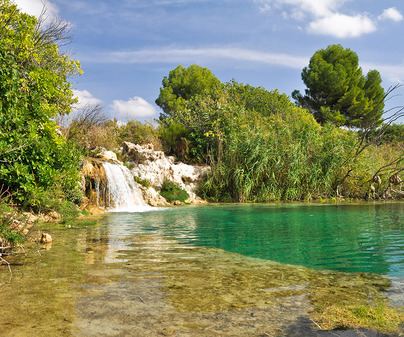Area 37.72 km² | Established 1979 | |
 | ||
Governing body Junta of Castile-La Mancha | ||
Lagunas de Ruidera Natural Park is a natural park in Spain, containing 15 small lakes, the Lagunas de Ruidera that are located in the La Mancha plain. Its area is more than 9,300 acres (38 km2). The lakes are connected by falls, small rivers as well as subterranean flow and the area is considered as the source of Guadiana River.

Once nicknamed "The Mirrors of La Mancha", the 16 interconnected lakes which make up the Parque Natural de las Lagunas de Ruidera stretch for 20 km through a valley. They allegedly take their time from a story in Don Quixote. Cervantes, in Don Quixote, says that there are seven of these small lakes; actually there are sixteen. You sense their presence even before you finally see them, after driving through some of the driest countryside in Spain. This, indeed, is Don Quixote country — La Mancha, the sunbaked Arabic ‘wilderness’ whose heatwaves had a notoriously hallucinogenic effect on the wits. The road from Argamasilla de Alba to Ruidera is lined with poplars and there are gentle undulations in the flat Manchegan landscape, announcing an imminent change of scenery.

At the Embalse de Peñarroya the plain turns into hills. The first natural lake along the route is Cenagosa, accompanied by an incessant clamour of birds, as the reeds and bullrushes along its shore provide perfect cover for many kinds of duck. The next lake is La Colgadilla, which receives much of its water via subterranean filtration from the great cave-cum-storage deposit known as the Cueva de la Morenilla.
Near the village of Ruidera are the two largest lakes, the Laguna del Rey and La Gran Colgada.
The road from Ruidera winds along their banks and gradually ascends from one lake to the next, for each is just a step higher than its neighbour. Just after several small lagunas — Batana, Santo Morcillo and Salvadora — is La Lengua, which is sausage-shaped and full of fish, hence much frequented by anglers. It receives most of its water via a row of small falls and rivulets that pour into it from the next link up in the chain, Redondilla. This, in turn, receives water from San Pedro, whose shore is partly lined with houses and plant nurseries. The highest and least visited is the Laguna Conceja, with its marshy shore-line and wooded surrounding hills. The Laguna Conceja has a higher degree of natural protection in respect of the rest of the lagoons.

The shores of Laguna Redondilla are pleasant and there is an abundance of birds. These crystalline lakes are in stark contrast with the parched maquis vegetation of the encircling hills.
The name Ruidera is said to derive from the noise (ruido) made by the water running from lake to lake, which stretches along a total of 25 kilometres (16 mi), with a difference of 128 metres (420 feet) in height between the southernmost pool, La Blanca, and Cenagosa at the northern end. Geologists have demonstrated that while some of the water runs from one lake to the other along surface streams and cascades, it also flows underground, through layers of clay and gypsum or sandstone.
The protected area of the Parque Natural de Ruidera includes not only the lakes but also the tributary valley of San Pedro, with the ruins of Rochafrida castle and the cave of Montesinos, which plays such an important role in the second part of Don Quixote. The ruins of the castle are perched close by the cave atop a limestone redoubt that overlooks a cultivated field, which must also have been a shallow pool before it was filled in by land reclamation.
These are literary landmarks. Rochafrida is mentioned in Spanish medieval romances, although it was already in ruins when Cervantes roamed this district as a tithe proctor for the Knights of St John at Argamasilla. Hence Don Quixote must go underground to meet the heroes of his ever-romantic imagination: Montesinos, Belerma, Durandarte. Here he learns that the inhabitants of the cave, Guadiana and Ruidera, together with their seven daughters and two nieces, have been transformed into a river and several lakes by Merlin the magician.
Indeed the traditional explanation is that the lake at the bottom of Montesinos’s cave, which is said to communicate with the Laguna de San Pedro via an underground stream, constitutes the real source of the Río Guadiana. The Lagunas de Ruidera, as a group, were reputed to be the head-waters of an eccentric and recalcitrant stream that went underground again after the Cenagosa, only to reappear 40 kilometres (25 mi) to the west, at the Tablas de Daimiel. Some geologists have recently questioned the hypothesis that this really is the subterranean Guadiana, and the argument continues to exercise some of the best scientific minds of Spain.
The great subterranean reservoir, through which the river supposedly flowed westward, has been tapped by the pumps of the wine-growers of Tomelloso, and the wetlands of the Tablas de Daimiel have ceased to be the great national park they once were. But the Lagunas de Ruidera are upstream from the pumps, and thus more precious than ever.
Conservation
UNESCO has included the natural park within the biosphere reserve Mancha Húmeda. The natural park acts as a buffer zone to the core area of the biosphere reserve, the Tablas de Daimiel.
